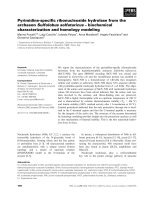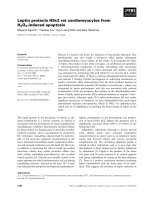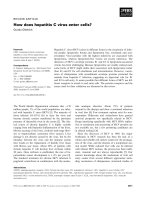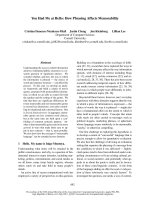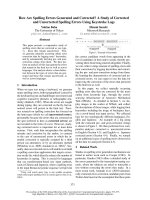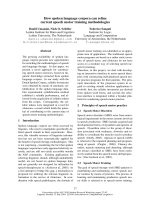Báo cáo khoa học: "How Much Can We Gain from Supervised Word Alignment" potx
Bạn đang xem bản rút gọn của tài liệu. Xem và tải ngay bản đầy đủ của tài liệu tại đây (70.12 KB, 5 trang )
Proceedings of the 49th Annual Meeting of the Association for Computational Linguistics:shortpapers, pages 165–169,
Portland, Oregon, June 19-24, 2011.
c
2011 Association for Computational Linguistics
How Much Can We Gain from Supervised Word Alignment?
Jinxi Xu and Jinying Chen
Raytheon BBN Technologies
10 Moulton Street, Cambridge, MA 02138, USA
{jxu,jchen}@bbn.com
Abstract
Word alignment is a central problem in sta-
tistical machine translation (SMT). In re-
cent years, supervised alignment algo-
rithms, which improve alignment accuracy
by mimicking human alignment, have at-
tracted a great deal of attention. The objec-
tive of this work is to explore the perform-
ance limit of supervised alignment under
the current SMT paradigm. Our experi-
ments used a manually aligned Chinese-
English corpus with 280K words recently
released by the Linguistic Data Consortium
(LDC). We treated the human alignment as
the oracle of supervised alignment. The re-
sult is surprising: the gain of human
alignment over a state of the art unsuper-
vised method (GIZA++) is less than 1 point
in BLEU. Furthermore, we showed the
benefit of improved alignment becomes
smaller with more training data, implying
the above limit also holds for large training
conditions.
1 Introduction
Word alignment is a central problem in statistical
machine translation (SMT). A recent trend in this
area of research is to exploit supervised learning to
improve alignment accuracy by mimicking human
alignment. Studies in this line of work include
Haghighi et al., 2009; DeNero and Klein, 2010;
Setiawan et al., 2010, just to name a few.
The objective of this work is to explore the per-
formance limit of supervised word alignment.
More specifically, we would like to know what
magnitude of gain in MT performance we can ex-
pect from supervised alignment over the state of
the art unsupervised alignment if we have access to
a large amount of parallel data. Since alignment
errors have been assumed to be a major hindrance
to good MT, an answer to such a question might
help us find new directions in MT research.
Our method is to use human alignment as the
oracle of supervised learning and compare its per-
formance against that of GIZA++ (Och and Ney
2003), a state of the art unsupervised aligner. Our
study was based on a manually aligned Chinese-
English corpus (Li, 2009) with 280K word tokens.
Such a study has been previously impossible due to
the lack of a hand-aligned corpus of sufficient size.
To our surprise, the gain in MT performance us-
ing human alignment is very small, less than 1
point in BLEU. Furthermore, our diagnostic ex-
periments indicate that the result is not an artifact
of small training size since alignment errors are
less harmful with more data.
We would like to stress that our result does not
mean we should discontinue research in improving
word alignment. Rather it shows that current trans-
lation models, of which the string-to-tree model
(Shen et al., 2008) used in this work is an example,
cannot fully utilize super-accurate word alignment.
In order to significantly improve MT quality we
need to improve both word alignment and the
translation model. In fact, we found that some of
the information in the LDC hand-aligned corpus
that might be useful for resolving certain transla-
tion ambiguities (e.g. verb tense, pronoun co-
references and modifier-head relations) is even
harmful to the system used in this work.
165
2 Experimental Setup
2.1 Description of MT System
We used a state of the art hierarchical decoder in
our experiments. The system exploits a string to
tree translation model, as described by Shen et al.
(2008). It uses a small set of linguistic and contex-
tual features, such as word translation probabilities,
rule translation probabilities, language model
scores, and target side dependency scores, to rank
translation hypotheses. In addition, it uses a large
number of discriminatively tuned features, which
were inspired by Chiang et al. (2009) and imple-
mented in a way described in (Devlin 2009). Some
of the features, e.g. context dependent word trans-
lation probabilities and discriminative word pairs,
are motivated in part to discount bad translation
rules caused by noisy word alignment. The system
used a 3-gram language model (LM) for decoding
and a 5-gram LM for rescoring. Both LMs were
trained on about 9 billion words of English text.
We tuned the system on a set of 4,171 sentences
and tested on a set of 4,060 sentences. Both sets
were drawn from the Chinese newswire develop-
ment data for the DARPA GALE program. On av-
erage, each sentence has around 1.7 reference
translations for both sets. The tuning metric was
BLEU, but we reported results in BLEU (Papineni
et al., 2002) and TER (Snover et al., 2006).
2.2 Hand Aligned Corpus
The hand aligned corpus we used is LDC2010E63,
which has around 280K words (English side). This
corpus was annotated with alignment links be-
tween Chinese characters and English words. Since
the MT system used in this work is word-based, we
converted the character-based alignment to word-
based alignment. We aligned Chinese word s to
English word t if and only if s contains a character
c that was aligned to t in the LDC annotation.
A unique feature of the LDC annotation is that
it contains information beyond simple word corre-
spondences. Some links, called special links in this
work, provide contextual information to resolve
ambiguities in tense, pronoun co-reference, modi-
fier-head relation and so forth. The special links
are similar to the so-called possible links described
in other studies (Och and Ney, 2003; Fraser and
Marcu, 2007), but are not identical. While such
links are useful for making high level inferences,
they cannot be effectively exploited by the transla-
tion model used in this work. Worse, they can hurt
its performance by hampering rule extraction.
Since the special links were marked with special
tags to distinguish them from regular links, we can
selectively remove them and check the impact on
MT performance.
Figure 1 shows an example sentence with hu-
man alignment. Solid lines indicate regular word
correspondences while dashed lines indicate spe-
cial links. Tags inside [] indicate additional infor-
mation about the function of the words connected
by special links.
Figure 1: An example sentence pair with human
alignment
2.3 Parallel Corpora and Alignment Schemes
Our experiments used two parallel training corpora,
aligned by alternative schemes, from which trans-
lation rules were extracted.
The corpora are:
• Small: the 280K word hand-aligned cor-
pus, with human alignment removed
• Large: a 31M word corpus of Chinese-
English text, comprising a number of
component corpora, one of which is the
small corpus
1
The alignment schemes are:
• giza-weak: Subdivide the large corpus into
110 chunks of equal size and run GIZA++
separately on each chunk. One of the
chunks is the small corpus mentioned
above. This produced low quality unsuper-
vised alignment.
1
Other data items included are LDC{2002E18,2002L27,
2005E83,2005T06,2005T10,2005T34,2006E24,2006E34,
2006E85,2006E92,2006G05,2007E06,2007E101,2007E46,
2007E87,2008E40,2009E16,2008E56}
Chinese: gei[OMN] ni ti gong jie shi
English: provide you with[OMN] an[DET] explanation
166
• giza-strong: Run GIZA++ on the large
corpus in one large chunk. Alignment for
the small corpus was extracted for experi-
ments involving the small corpus. This
produced high quality unsupervised align-
ment.
• gold-original: human alignment, including
special links
• gold-clean: human alignment, excluding
special links
Needless to say, gold alignment schemes do not
apply to the large corpus.
3 Results
3.1 Results on Small Corpus
The results are shown in Table 2. The special links
in the human alignment hurt MT (Table 2, gold-
original vs. gold-clean). In fact, with such links,
human alignment is worse than unsupervised
alignment (Table 2, gold-original vs. giza-strong).
After removing such links, human alignment is
better than unsupervised alignment, but the gain is
small, 0.72 point in BLEU (Table 2, gold-clean vs.
giza-strong). As expected, having access to more
training data increases the quality of unsupervised
alignment (Table 1) and as a result the MT per-
formance (Table 2, giza-strong vs. giza-weak).
Alignment Precision Recall F
gold-clean 1.00 1.00 1.00
giza-strong 0.81 0.72 0.76
giza-weak 0.65 0.58 0.61
Table 1: Precision, recall and F score of different
alignment schemes. F score is the harmonic mean
of precision and recall.
Alignment BLEU TER
giza-weak 18.73 70.50
giza-strong 21.94 66.70
gold-original 20.81 67.50
gold-clean 22.66 65.92
Table 2: MT results (lower case) on small corpus
It is interesting to note that from giza-weak to giza-
strong, alignment accuracy improves by 15% and
the BLEU score improves by 3.2 points. In com-
parison, from giza-strong to gold-clean, alignment
accuracy improves by 24% but BLEU score only
improves by 0.72 point. This anomaly can be
partly explained by the inherent ambiguity of word
alignment. For example, Melamed (1998) reported
inter annotator agreement for human alignments in
the 80% range. The LDC corpus used in this work
has a higher agreement, about 90% (Li et al.,
2010). That means much of the disagreement be-
tween giza-strong and gold alignments is probably
due to arbitrariness in the gold alignment.
3.2 Results on Large Corpus
As discussed before, the gain using human align-
ment over GIZA++ is small on the small corpus.
One may wonder whether the small magnitude of
the improvement is an artifact of the small size of
the training corpus.
To dispel the above concern, we ran diagnostic
experiments on the large corpus to show that with
more training data, the benefit from improved
alignment is less critical. The results are shown in
Table 3. On the large corpus, the difference be-
tween good and poor unsupervised alignments is
2.37 points in BLEU (Table 3, giza-strong vs. giza-
weak). In contrast, the difference between the two
schemes is larger on the small corpus, 3.21 points
in BLEU (Table 2, giza-strong vs. giza-weak).
Since the quality of alignment of each scheme does
not change with corpus size, the results indicate
that alignment errors are less harmful with more
training data. We can therefore conclude the small
magnitude of the gain using human alignment is
not an artifact of small training.
Comparing giza-strong of Table 3 with giza-
strong of Table 2, we can see the difference in MT
performance is about 8 points in BLEU (20.94 vs.
30.21). This result is reasonable since the small
corpus is two orders of magnitude smaller than the
large corpus.
Alignment BLEU TER
giza-weak 27.84 59.38
giza-strong 30.21 56.62
Table 3: MT results (lower case) on large corpus
167
3.3 Discussions
Some studies on supervised alignment (e.g.
Haghighi et al., 2009; DeNero and Klein, 2010)
reported improvements greater than the limit we
established using an oracle aligner. This seemingly
inconsistency can be explained by a number of
factors. First, we used more data (31M) to train
GIZA++, which improved the quality of unsuper-
vised alignment. Second, some of the features in
the MT system used in this work, such as context
dependent word translation probabilities and dis-
criminatively trained penalties for certain word
pairs, are designed to discount incorrect translation
rules caused by alignment errors. Third, the large
language model (trained with 9 billion words) in
our experiments further alleviated the impact of
incorrect translation rules. Fourth, the GALE test
set has fewer reference translations than the NIST
test sets typically used by other researchers (1.7
references for GALE, 4 references for NIST). It is
well known that BLEU is very sensitive to the
number of references used for scoring. Had we
used a test set with more references, the improve-
ment in BLEU score would probably be higher. An
area for future work is to examine the impact of
each factor on BLEU score. While these factors
can affect the numerical value of our result, they
do not affect our main conclusion: Improving word
alignment alone will not produce a breakthrough in
MT quality.
DeNero and Klein (2010) described a technique
to exploit possible links, which are similar to spe-
cial links in the LDC hand aligned data, to improve
rule coverage. They extracted rules with and with-
out possible links and used the union of the ex-
tracted rules in decoding. We applied the technique
on the LDC hand aligned data but got no gain in
MT performance.
Our work assumes that unsupervised aligners
have access to a large amount of training data. For
language pairs with limited training, unsupervised
methods do not work well. In such cases, super-
vised methods can make a bigger difference.
4 Related Work
The study of the relation between alignment qual-
ity and MT performance can be traced as far as to
Och and Ney, 2003. A more recent study in this
area is Fraser and Marcu, 2007. Unlike our work,
both studies did not report MT results using oracle
alignment.
Recent work in supervised alignment include
Haghighi et al., 2009; DeNero and Klein, 2010;
Setiawan et al., 2010, just to name a few. Fossum
et al. (2008) used a heuristic based method to de-
lete problematic alignment links and improve MT.
Li (2009) described the annotation guideline of
the hand aligned corpus (LDC2010E63) used in
this work. This corpus is at least an order of mag-
nitude larger than similar corpora. Without it this
work would not be possible.
5 Conclusions
Our experiments showed that even with human
alignment, further improvement in MT quality will
be small with the current SMT paradigm. Our ex-
periments also showed that certain alignment in-
formation suitable for making complex inferences
can even hamper current SMT models. A future
direction for SMT is to develop translation models
that can effectively employ such information.
Acknowledgments
This work was supported by DARPA/IPTO Con-
tract No. HR0011-06-C-0022 under the GALE
program
2
(Approved for Public Release, Distribu-
tion Unlimited). The authors are grateful to Mi-
chael Kayser for suggestions to improve the pres-
entation of this paper.
References
David Chiang, Kevin Knight, and Wei Wang. 2009.
11,001 new features for statistical machine transla-
tion. In Proceedings of Human Language Technolo-
gies: The 2009 Annual Conference of the North
American Chapter of the ACL, pages 218–226.
John DeNero and Dan Klein. 2010. Discriminative
Modeling of Extraction Sets for Machine Translation.
In Proceedings of the 48th Annual Meeting of the As-
sociation for Computational Linguistics, pages 1453–
1463.
2
The views, opinions, and/or findings contained in this arti-
cle/presentation are those of the author/presenter and should
not be interpreted as representing the official views or policies,
either expressed or implied, of the Defense Advanced Re-
search Projects Agency or the Department of Defense.
168
Jacob Devlin. 2009. Lexical features for statistical ma-
chine translation. Master’s thesis, University of
Maryland.
Victoria Fossum, Kevin Knight and Steven Abney.
2008. Using Syntax to Improve Word Alignment
Precision for Syntax-Based Machine Translation, In
Proceedings of the third Workshop on Statistical MT,
ACL, pages 44-52.
Alexander Fraser and Daniel Marcu. 2007. Measuring
Word Alignment Quality for Statistical Machine
Translation. Computational Linguistics. 33(3): 293-
303.
Aria Haghighi, John Blitzer, John DeNero and Dan
Klein. 2009. Better word alignments with supervised
ITG models, In Proceedings of the Joint Conference
of the 47th Annual Meeting of the ACL and the 4th
International Joint Conference on Natural Language
Processing of the AFNLP, pages 923-931.
Xuansong Li. 2009. Guidelines for Chinese-English
Word Alignment, Version 4.0, April 16, 2009,
Xuansong Li, Niyu Ge, Stephen Grimes, Stephanie M.
Strassel and Kazuaki Maeda. 2010. Enriching Word
Alignment with Linguistic Tags. In Proceedings of
the Seventh International Conference on Language
Resources and Evaluation, Valletta, Malta.
Dan Melamed. 1998. Manual annotation of translational
equivalence: The blinker project. Technical Report
98-07, Institute for Research in Cognitive Science,
Philadelphia.
Franz Josef Och and Hermann Ney. 2003. A systematic
comparison of various statistical alignment models.
Computational Linguistics, 29(1):19-51.
Kishore Papineni, Salim Roukos, Todd Ward, and Wei-
Jing Zhu. 2002. BLEU: a method for automatic
evaluation of machine translation. In Proceedings of
the 40th Annual Meeting of the Association for Com-
putational Linguistics, pages 311–318.
Hendra Setiawan, Chris Dyer, and Philip Resnik. 2010.
Discriminative Word Alignment with a Function
Word Reordering Model. In Proceedings of 2010
Conference on Empirical Methods in Natural Lan-
guage Processing, pages 534–544.
Libin Shen, Jinxi Xu, and Ralph Weischedel. 2008. A
new string-to-dependency machine translation algo-
rithm with a target dependency language model. In
Proceedings of ACL-08: HLT, pages 577–585.
Matthew Snover, Bonnie Dorr, Richard Schwartz, Linea
Micciulla, and John Makhoul. 2006. A Study of
Translation Edit Rate with Targeted Human Annota-
tion. In Proceedings of Association for Machine
Translation in the Americas, pages 223-231.
169


